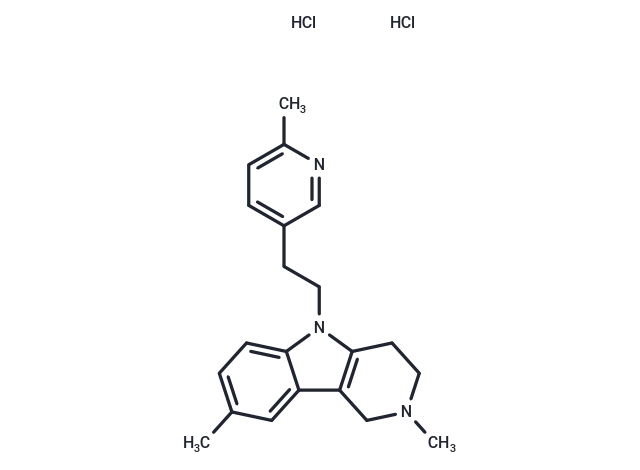Shopping Cart
- Remove All
 Your shopping cart is currently empty
Your shopping cart is currently empty

Latrepirdine dihydrochloride (Dimebolin dihydrochloride) is an orally active, and neuroactive antagonist of multiple drug targets, including histamine receptors, GluR, and 5-HT receptors, used as an antihistamine drug.

| Pack Size | Price | Availability | Quantity |
|---|---|---|---|
| 2 mg | $30 | In Stock | |
| 1 mL x 10 mM (in DMSO) | $48 | In Stock |
| Description | Latrepirdine dihydrochloride (Dimebolin dihydrochloride) is an orally active, and neuroactive antagonist of multiple drug targets, including histamine receptors, GluR, and 5-HT receptors, used as an antihistamine drug. |
| In vitro | Latrepirdine increases succinate dehydrogenase activity (MTT-assay), mitochondrial membrane potential (DeltaPsim), and cellular ATP levels in primary mouse cortical neurons and human neuroblastoma cells (SH-SY5Y). Latrepirdine enhances mitochondrial function both in the absence and presence of stress and Dimebon-treated cells are partially protected to maintain cell viability. [1] Latrepirdine leads to enhanced mTOR- and Atg5-dependent autophagy in cultured mammalian cells. [2] latrepirdine stimulates MTOR- and ATG5-dependent autophagy, leading to the reduction of intracellular levels of APP metabolites, including Aβ in cultured cells. [3] Latrepirdine stimulates the degradation of α-syn in differentiated SH-SY5Y neurons, and in mouse brain following chronic administration, in parallel with elevation of the levels of markers of autophagic activity. [4] Latrepirdine increases intracellular ATP levels and glucose transporter 3 translocation to the plasma membrane in primary neuron. [5] |
| In vivo | Latrepirdine treatment of TgCRND8 transgenic mice is linked to improved learning behavior and reduced accumulation of Aβ42 and α-synuclein. [2] Latrepirdine administration results in increased levels of biomarkers associated with autophagy activation in the brains of TgCRND8 (APP K670M, N671L, V717F) or wild-type mice, and is also associated with behavioral improvement, reduced Aβ neuropathology, and prevention of autophagic failure in TgCRND8 mice. [3] |
| Alias | Latrepirdine 2HCl, Dimebolin dihydrochloride |
| Molecular Weight | 392.37 |
| Formula | C21H25N3·2HCl |
| Cas No. | 97657-92-6 |
| Smiles | Cl.Cl.CN1CCc2c(C1)c1cc(C)ccc1n2CCc1ccc(C)nc1 |
| Relative Density. | no data available |
| Storage | store at low temperature | Powder: -20°C for 3 years | In solvent: -80°C for 1 year | Shipping with blue ice. | ||||||||||||||||||||||||||||||
| Solubility Information | DMSO: 39.2 mg/mL (99.91 mM), Sonication is recommended. | ||||||||||||||||||||||||||||||
Solution Preparation Table | |||||||||||||||||||||||||||||||
DMSO
| |||||||||||||||||||||||||||||||

Copyright © 2015-2025 TargetMol Chemicals Inc. All Rights Reserved.